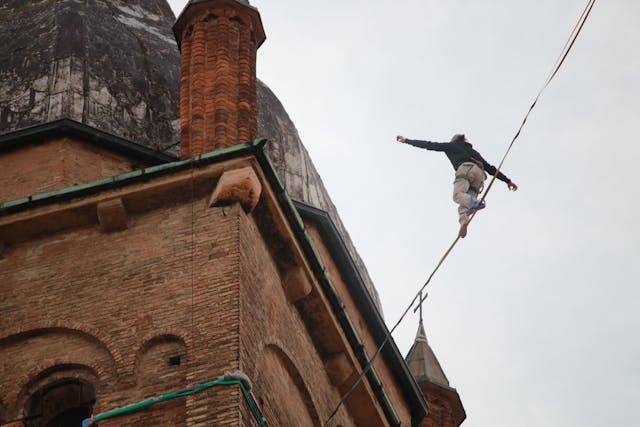
How does our balance work? We balance by using our visual system, our proprioceptive system, and our vestibular system. The visual system is obviously our eyes, the proprioceptive system is in our muscles and joints, and the vestibular system is in our inner ears.
Some people have much better balance than others, but we all have pretty good balance because we can stand upright and move without any problem. Some animals, such as cats, have a much better sense of balance than we do, but they also have a tail they can use as a counterweight. We do the same thing with our arms. If you are trying to balance on something, or if you are starting to fall, you will automatically stick your arms out to counterbalance yourself. This works because we need to have our center of balance pretty much over our feet to be able to stay upright. The center of balance is the point where all of the gravitational forces in every direction are completely zero. If you can get something with an irregular shape to balance, you have managed to find the center of balance because there are no forces pulling it in any direction. This is true with our bodies when we are standing upright. However, if you start to fall over, let’s say to the right, your center of mass will start to shift to the right, and off your feet, the point of contact with the ground. If you don’t counter this, you will continue to go that way until it is unrecoverable. Thrusting your arms out in the opposite direction moves about 5% of your body mass in the opposite direction to the way you are falling, and readjusts your center of balance. That can be enough to regain your balance.
So, how do we balance? We use three systems together to balance. You can balance with just two of them, but it is harder. It is very difficult to balance with only one of them. The systems don’t work alone, but the brain compares signals from all of them at the same time to constantly adjust its balance. The first thing is the eyes. The eyes can tell the brain the position of the head and the body, but, more importantly, it can tell the brain about motion. If you are falling over, the eyes can send the motion signal to the brain. You can balance without your eyes, blind people obviously do it, but it is more difficult. Try standing on one leg and then closing your eyes.
The second system is the proprioceptive system. Our muscles, tendons, and joints all have sensors in them called proprioceptors. These sensors can tell the position of a muscle, joint or limb. They can also tell the load upon it and whether it is moving or not. By knowing where the load is coming from, they can tell in which direction it is moving. These receptors send information to the brain and they allow the brain to make micro adjustments to keep us balanced. The brain uses information from this situation and compares it to information coming in from the eyes.
The third system, and probably the most important, is the vestibular system in the ears. The vestibular system is made up of semicircular canals and something called otolith organs. The semicircular canals contain fluid and tiny hair cells. When we move our head, the fluid in the semicircular canal doesn’t move quite as quickly, and it is pushed to the side of the canal. This moves the hair cells there and they translate that movement into an electrical signal that they send to the brain. When we stop moving, the fluid catches up and moves the hair cells on the other side, sending another signal. We have three semicircular canals that go in different directions and each one detects movement in a different direction. The superior canal detects movements up and down, like nodding your head. The posterior canal detects side to side motion, like shaking your head. The lateral canal detects tilting motion, like tilting your head to one side. By combining signals from all of these canals, the brain can work out which way the head is moving. We also have two otolith organs. They allow us to feel acceleration. They are filled with a gel and calcium carbonate crystals. The organs also have hair cells on their sides. When you move, the acceleration presses the crystals against the hairs, which sends a signal to the brain. These organs can tell acceleration forwards and backwards, sidewards, and up and down.
The brain combines all of the information from these systems to constantly adjust our muscles so that we are balancing. Sometimes, when we are on a boat, for example, our eyes and our vestibular systems send different signals and we end up getting sick. And this is what I learned today.
Sources
https://www.ncbi.nlm.nih.gov/books/NBK279394
https://en.wikipedia.org/wiki/Otolith
https://www.nwh.org/media/file/how_does_the_balance_system_work1.pdf
https://en.wikipedia.org/wiki/Proprioception
https://en.wikipedia.org/wiki/Center_of_mass
Photo by Canio Tiri: https://www.pexels.com/photo/acrobat-walking-on-line-on-church-19453297/
